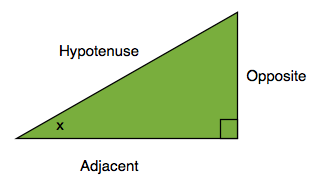Trigonometry: Sine, Cosine, and Tangent

This post is part of a series of posts on Trigonometry. To see all the posts, click on the tag #TrigonometryTutorials below. This is the post you should read before you read this.
In a Right-angled Triangle, take one of the angles that isn't the right angle and call it . The side that is the longest and is opposite to the right angle is called the Hypotenuse, as you already know.
The side that is next to the angle and isn't the Hypotenuse is called the Adjacent side, a good way to remember this is that adjacent means "next to"
The remaining side is called the Opposite side, you can remember this because the side is opposite to the angle
Notice if you chose the other angle that isn't the Adjacent and the Opposite sides would have switched around.
As I have said in my previous post, A Triangle is stable and if you know the 3 angles of a triangle you can find the ratio of the 3 sides of the Triangle. This is what the Trig ratios: Sine, Cosine, and Tangent are for.
Sine, Cosine and Tangent are often abbreviated to , , and and I will also do so when I refer to them later on.
This is what the Ratios are:
For a Right-Angled Triangle and an angle :
A good way to Memorise this is: "SOHCAHTOA", it stands for:
Sine is Opposite divided by Hypotenuse
Cosine is Adjacent divided by Hypotenuse
Tangent is Opposite divided be Adjacent
This is very useful. For example say you have a right angled Triangle and one of the other angles is . The Hypotenuse is 4 units, what is the length of the Opposite?
Using a Calculator you will find that , this means the ratio between the Opposite and the Hypotenuse is since we know the hypotenuse is 4:
And we find that the Opposite side has length 2.
There are other Trig Functions which can be used in the same way: Secant (), Cosecant (), and Cotangent (), but these are not used as often:
The next post in this series is here
Easy Math Editor
This discussion board is a place to discuss our Daily Challenges and the math and science related to those challenges. Explanations are more than just a solution — they should explain the steps and thinking strategies that you used to obtain the solution. Comments should further the discussion of math and science.
When posting on Brilliant:
*italics*or_italics_**bold**or__bold__paragraph 1
paragraph 2
[example link](https://brilliant.org)> This is a quote# I indented these lines # 4 spaces, and now they show # up as a code block. print "hello world"\(...\)or\[...\]to ensure proper formatting.2 \times 32^{34}a_{i-1}\frac{2}{3}\sqrt{2}\sum_{i=1}^3\sin \theta\boxed{123}Comments
There are no comments in this discussion.